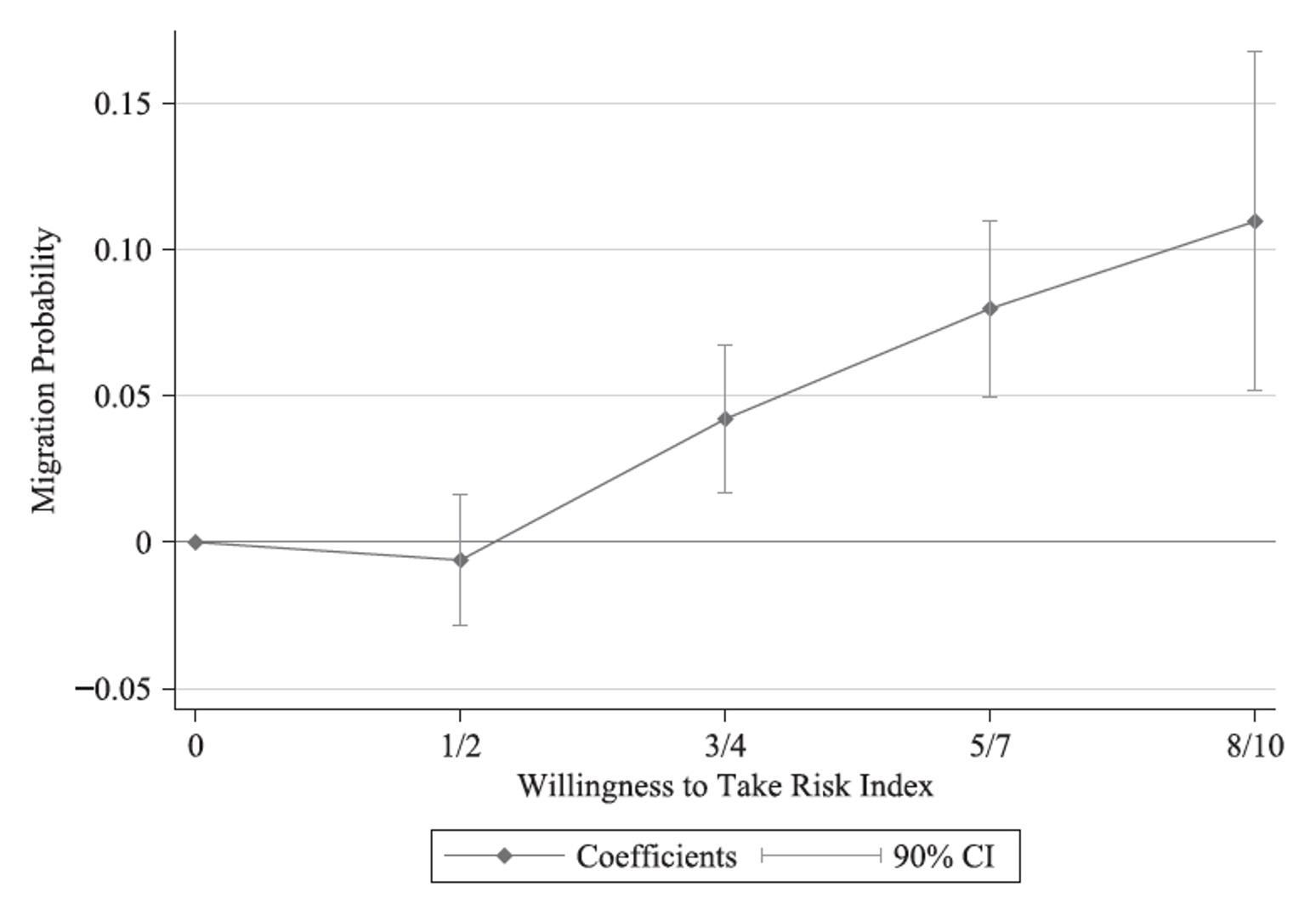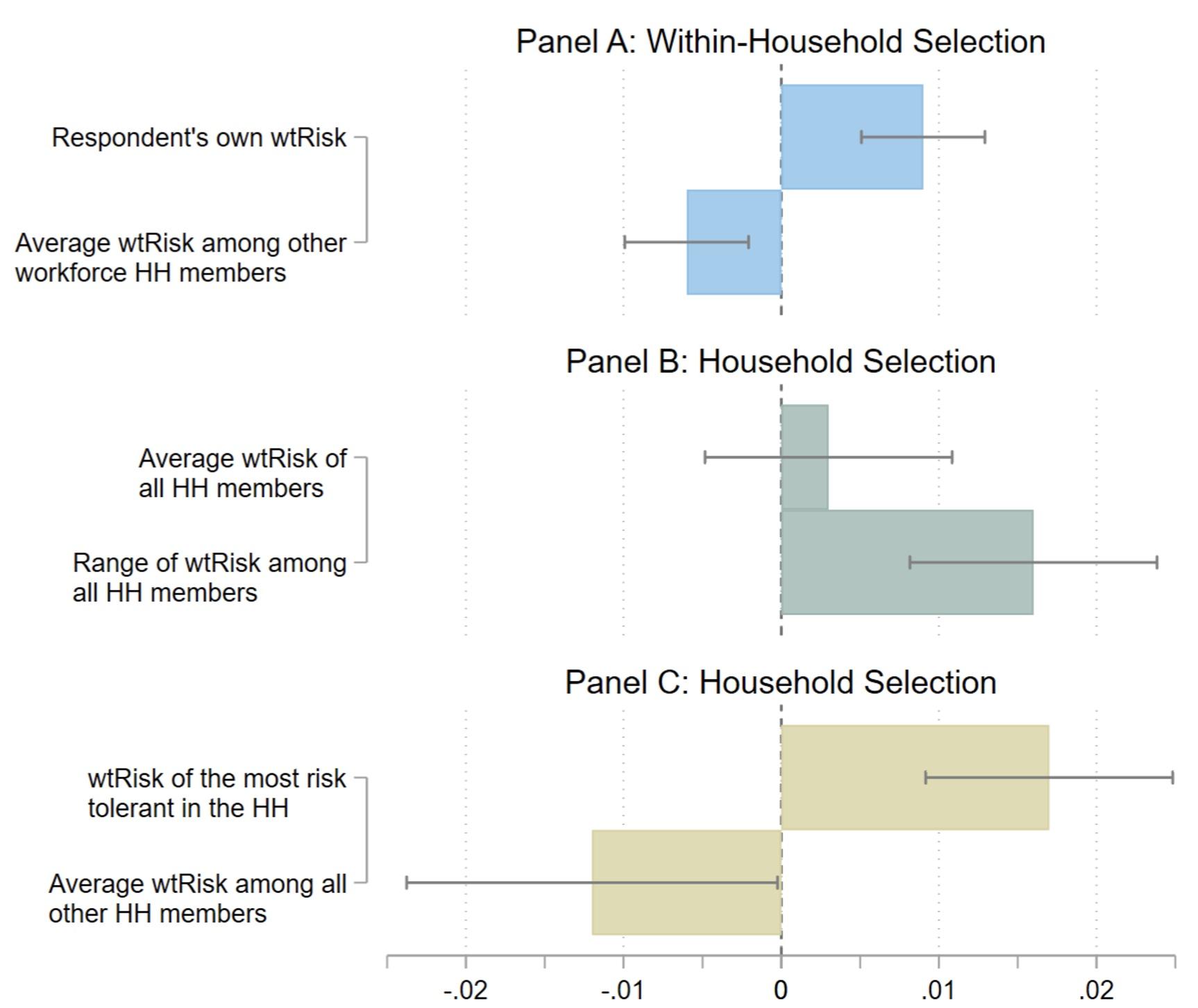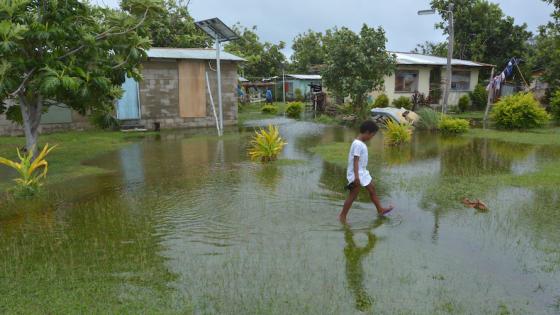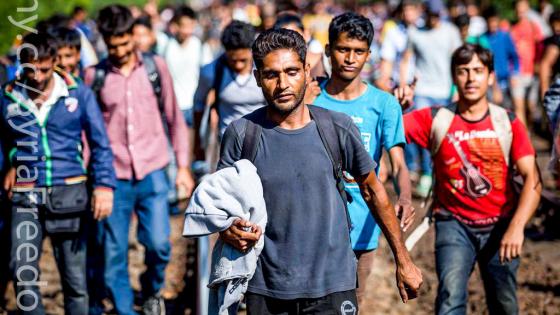While migration can be risky, the future economic outlook in origin countries can also pose significant uncertainties. For instance, families relying on agricultural subsistence production face unpredictable harvest outlooks subject to weather conditions and various other circumstances, while individuals who migrate to cities may encounter risks and economic uncertainty. Nonetheless, when a household member migrates, the overall income uncertainty for the entire family is reduced since the shocks to the migrant’s earnings in the city and the family’s agricultural harvest are either uncorrelated or weakly correlated. As a result, migration can mitigate the overall risk that the household faces.
The role of migration on risk diversification has been analysed in studies that explore both individual (e.g. Dustmann 1997) and household migration decisions (see e.g. Rosenzweig and Stark 1989). In recently published work (Dustmann et al. 2023), we turn this analysis on its head. Rather than investigating what impact migration has on risk reduction, we ask how the possibility of risk reduction through migration impacts the migration decision itself, how this decision is affected by other household members’ attitudes to risk, and how the possibility of risk diversification influences the selection of the family member who will migrate. This highlights risk reduction for the entire household as an important benefit of migration. It may thus lead to migrations that could be considered irrational when assessed from a purely individual perspective.
Risk diversification and household’s migration decision
The intuition of our analysis in Dustmann et al. (2023) is straightforward. Households that are highly risk-averse seek to diversify their income sources, which can be achieved through the migration of a household member. While the potential migrant may incur substantial exposure to uncertainty through the migration, this cost decreases with the individual’s level of risk aversion. Consequently, the migration of one household member is, ceteris paribus, the more beneficial for a household the less risk-averse the potential migrant, and the more risk-averse the remaining household members.
We formalise these ideas in a simple model of household migration decisions, accounting for heterogeneous risk preferences among family members in a setting where the household chooses not only whether to send a migrant but also which member to send. The model provides two novel and distinctive predictions, following from the intuition we develop above. First, the likelihood of an individual’s migration increases with the risk aversion of other household members (while it decreases with their own risk aversion). Second, households with larger heterogeneity in risk attitudes are more likely to send a migrant than similar households with the same mean in risk aversion but a lower variance.
The empirical test
We test these predictions using data on internal migration in China that elicit willingness to take risks from migrants and non-migrant family members (the RUMiC Survey). This allows the construction of the entire distribution of risk preferences for each household.
Individual selection
We first show that individuals who migrate are indeed less risk-averse than those who do not migrate, a result robust to controlling for a long list of individual, household, and community characteristics. The effect is economically relevant: a one standard deviation increase in the willingness to take risks is associated with an 11–14% increase in the migration probability (Figure 1). This result supports previous findings in the literature (Jaeger et al. 2010, Gibson and McKenzie 2011).
Figure 1 Willingness to take risks and migration
Within-household selection
We next study whether the risk aversion of other household members affects an individual’s migration probability by comparing individuals with the same risk aversion who belong to households where other members have different average risk attitudes. We find indeed that individuals from more risk-averse households are more likely to migrate, conditional on their own risk attitude (Figure 2, Panel A). These findings are robust to alternative specifications, all showing that relative measures of risk attitudes affect an individual’s probability of migration over and above the individual’s risk preference.
Household selection
Finally, we explore which households are more likely to send migrants and how this depends on the distribution of risk preferences among household members. We find that, for the same average risk aversion, households with more dispersed risk preferences are more likely to send migrants (Figure 2, Panel B). The gain in household utility from sending a migrant increases the risk aversion of the member(s) who stay behind as well as the willingness to take risks of the least risk-averse member who is most likely to migrate. Further, we show that the probability of sending a migrant increases with the presence of a more risk-tolerant individual and decreases with the other (non-migrant) members’ willingness to take risks (Figure 2, Panel C).
Figure 2 Willingness to take risks (wtRisk), individual and household selection to migrate
These findings, therefore, suggest that the distribution of risk attitudes within the household plays an important role in the household’s decision to send a migrant. Households with a high demand for risk diversification and with sufficiently risk-tolerant individuals prepared to migrate are more likely to have a migrant member. The mechanisms we consider – both theoretically and empirically – are not specific to the Chinese context and are generalisable to other settings where the household plays a role in the migration decisions of individual members and where risk spreading is an important component of those decisions.
Implications and conclusions
This work has important implications for key policy issues in the area of migratory movements.
First, considering the possibility that an important driver of a migration decision is the reduction of overall household risk to future income shocks helps makes sense of migration decisions that seem irrational when the individual is considered in isolation. This aspect may help explain migrations by undocumented migrants who attempt to reach European countries (Prarolo et al. 2019) and endure large risks and substantial uncertainty not just during their journey but after their arrival as well. It is often assumed that ‘these individuals would not have made the journey if they only knew the substantial risks that were involved’, an assumption that suggests a lack of information led to the migration in the first place and that information campaigns may discourage further migration. However, rather than being poorly informed or altogether irrational, these decisions may be taken at the household level, where extreme poverty and insecurity coupled with high uncertainty about how to make a future living could lead to migrations that bear far more exposure to risk than if migration decisions were taken on an individual level.
Second, our analysis in Dustmann et al. (2023) also suggests that entire households do not need to relocate in response to higher uncertainty. Rather, it may suffice to engage in risk diversification through the migration of some household members, thereby reducing the level of risk exposure for the entire household. This insight is important for assessing how global warming affects migration patterns (Sasahara and Peri 2019) and for forecasting future migrations that respond to climate change (Docquier et al. 2019). Predictions based on models of individual migration decisions may overestimate the potential flows of ‘climate refugees’ and misrepresent migration patterns we are likely to observe in countries exposed to higher weather variability.
References
Docquier, F, J de Melo, C Deuster and M Burzyński (2019), “Climate migration frightens... climate poverty is frightening!”, VoxEU.org, 10 December.
Dustmann, C, F Fasani, X Meng and L Minale (2023), “Risk Attitudes and Household Migration Decisions”, Journal of Human Resources 58: 112–145.
Dustmann, C (1997), “Return Migration, Uncertainty and Precautionary Savings”, Journal of Development Economics 52(2): 295–316.
Gibson, J and D McKenzie (2011), “The Microeconomic Determinants of Emigration and Return Migration of the Best and Brightest: Evidence from the Pacific”, Journal of Development Economics 95:18–29.
Prarolo, G, M Manchin, M Mendola and Guido Friebel (2019), “Migration route length and intent to migrate: The case of post-Gaddafi Libya”, VoxEU.org, 2 February.
Rosenzweig, M R and O Stark (1989), “Consumption Smoothing, Migration, and Marriage: Evidence from Rural India”, Journal of Political Economy 97(4): 905–926.
Sasahara, A and G Peri (2019), “The effects of global warming on rural–urban migrations”, VoxEU.org, 15 July.
Jaeger, D A, T Dohmen, A Falk, D Huffman, U Sunde and H Bonin (2010), “Direct Evidence on Risk Attitudes and Migration”, Review of Economics and Statistics 92(3): 684–689.









